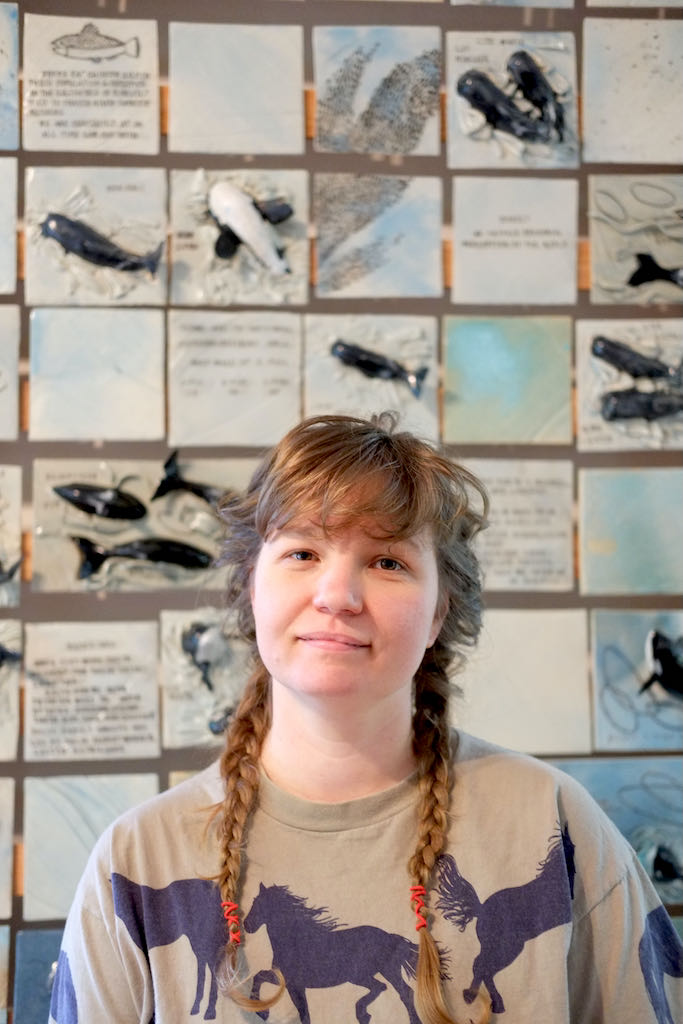Clare Wilkening – A Conversation With Nature Through Ceramics
May 25, 2022Clare Wilkening is an emerging ceramic artist from Vancouver, BC. Completely gripped by clay, her singular, highly evocative work explores themes of ecology and sustainability, as well as the responsibilities of being born and raised as a settler on xʷməθkʷəy̓əm, sḵwx̱wú7mesh, and Tsleil-Waututh territories.
In the run-up to her upcoming demo with Opus, Lucky Bats and Clay Wheel Techniques, on June 9, 2022, we’re delighted to have caught up with Clare to discuss her vision, practice and tools – including the pottery system she helped design, which helps make the ceramics process easier for everyone!
Please introduce yourself as a potter and your pottery practice.
What type of pottery do you do? Why did you get into pottery? What do you love about it?
I am an emerging ceramic artist with a focus on ecologies, human and non-human, and the major and subtle linkages therein. In my work I utilize ceramic forms to evoke, narrate, and to respond to specific places and ecological issues. I make wheel-thrown tableware, coil-built animal sculptures, and large-scale tile installations.
I choose to work primarily in ceramics because of the material’s direct connection to the ground, which has inherent power and meaning. I uncover that by choosing a material that can be a bridge between the topic of my work, the object that is the work, and the substrate of our existence. We are all subjects of the ground, and the ground is subjected to all of us.
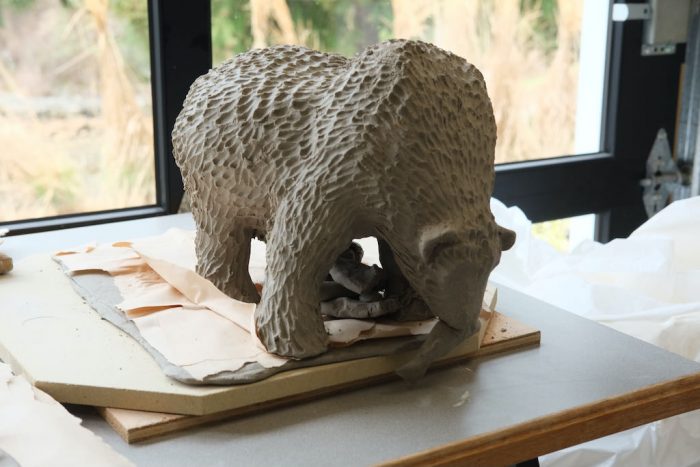
This spring, we’ve been talking with artists about our theme Conversations With Nature. Nature and the environment seem to play a big role in your artwork.
How do you bring nature into your work? Why is nature important to you?
The impulses and ideas for my work begin with a broad love for the natural world. I relish the experiences I have had within the felt world of ecology, and I try to bring forth that spirit of creative intuition, play and levity in my working processes. Nature is where my heart is at peace. I feel that non-human life has inherent value, and that connection with nature can bring a richness to our lives that we wouldn’t otherwise know.
Much of my artwork parallels and expands upon my BSc in Environmental Science and the information and knowledge I gained during that time. By choosing to engage with ecology as an artist instead of as a scientist, I am able to research the many topics that hold my attention and to generate work that is evocative and responsive. My goal is to address the social aspects of ecological degradation by offering arts-based ways of portraying whole systems and broad, inclusive thinking that puts ecological health ahead of industrial extraction.
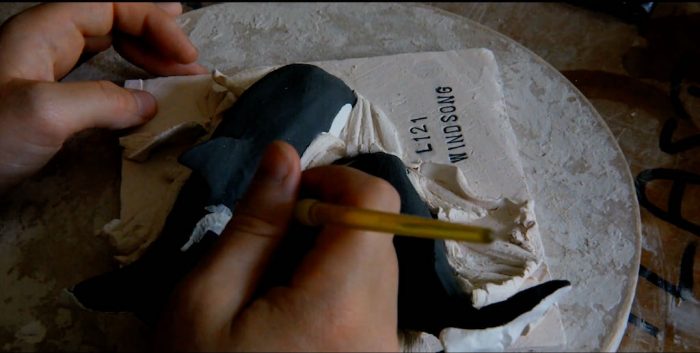
How does your work reflect your thoughts and feelings about nature?
Are there issues/things you’re trying to comment on or bring attention to through your artwork? What do you hope to achieve?
In my work, I wish to challenge the gesture of sustainability beyond its current cultural logic: a means to maintain resource levels for future extraction at worst, and as a buzzword at best. I would like to shift environmental thinking from the language of sustainability and efficiency towards engagement in reciprocal and regenerative care. Much of the thinking and practice around reciprocity with nature has been done by Indigenous scholars and artists, and I have been fortunate enough to have this decolonial discourse play a heavy role in my education. My positionality as a settler making art within which land and water are actants is an ongoing dialogue within my work.
I have been working on a large ceramic project meant to connect myself, my community, and the citizens of Vancouver and beyond with our neighbours: the Southern Resident Killer Whales (SRKW). These orca migrate annually between the open ocean and the Salish Sea, and feed nearly exclusively on Chinook salmon, which are overfished and threatened by disease and climate change. Orca live complex, emotional lives with their families, and they have been doing so for countless generations. There are currently only 73 individuals left in this unique subspecies, and the time is now to take actions to care for them, or else face a future without them.
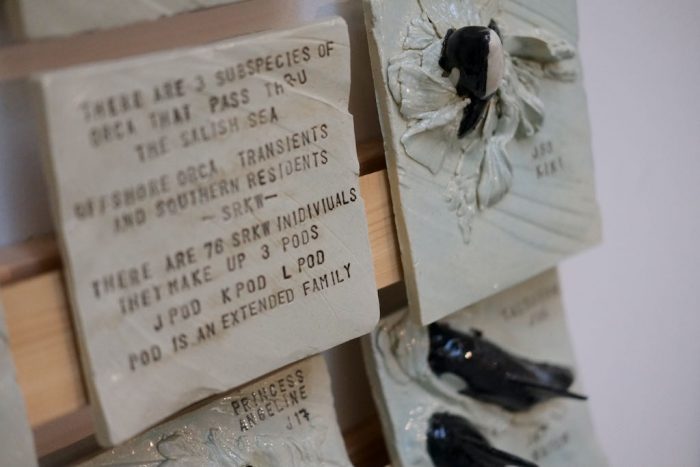
In this installation there is a ceramic tile representing each actual Southern Resident killer whale. Each whale is individually sculpted and painted with accurate dorsal markings, and has their name, pod, and scientific ID number stamped into the tile. Mothers and their calves appear together on the same tile, as well as sometimes other close relatives. Other tiles are flat and covered with glaze or text bringing context to the ecology of the species. There are currently 186 tiles in the work. The whales are assembled across the surface of the work according to the family groups that they swim with in the real-world. The viewer sees the entire Southern Resident population swimming over the ocean.
For me, thinking about them out there, living their lives in matrilineal, non-material societies, gives me a feeling of peace when life in this city overwhelms me. But of course they bear the brunt of our hyper-consumer lives. I try to convey all this with these tiles. I am continually updating the tiles with the births and deaths in the population, and plan to do so for the rest of my lifetime. Hopefully it will be an exercise in watching their lives grow and thrive, rather than dwindle and flicker out. I started this project on the day that I heard over the radio that BC’s Selkirk Mountain Caribou herd had gone extinct. This project is a gesture of hope and action towards that same day never occurring for the Southern Residents.
The project can be seen online at clarewilkening.com/orca-tiles, and I try to get it up in public around Vancouver and the Salish Sea as often as I can.
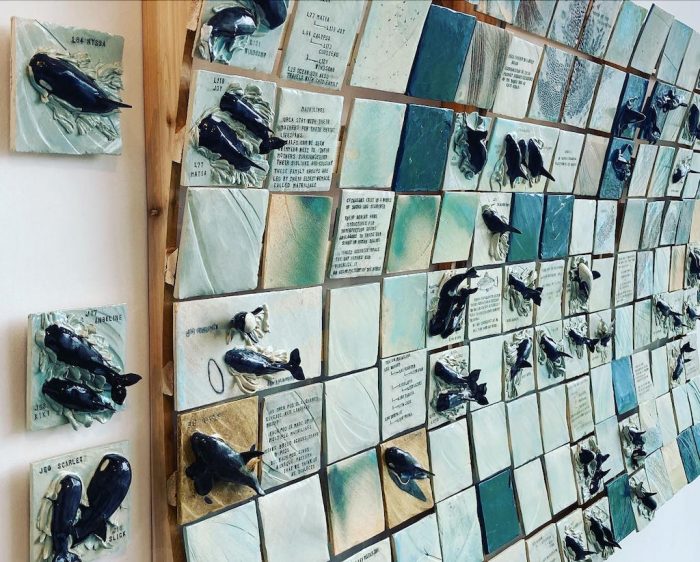
You’ve recently done an artist residency at Tidal Art Centre on the Sunshine Coast.
How did that experience come to be? How does your art tie in with a place like Tidal?
My artist residency at Tidal Art Centre in Lund came to be because the Director of the Centre saw my whale tile project and invited me to apply for the residency, which I did. Tidal is a beautiful restored Forest Ranger building, overlooking Finn Bay, that has been turned into art studios and a gallery.
Waking up there every morning for two months, and seeing the ocean first thing, was wonderful fodder for my practice. I started making large coil-built animal sculptures while I was there: humpback whales lunge-feeding, grizzly bears fishing for salmon, and loons. I learned to raku fire. It has been wonderful to expand my practice into a whole new type of working, a new way of making about the Salish Sea.
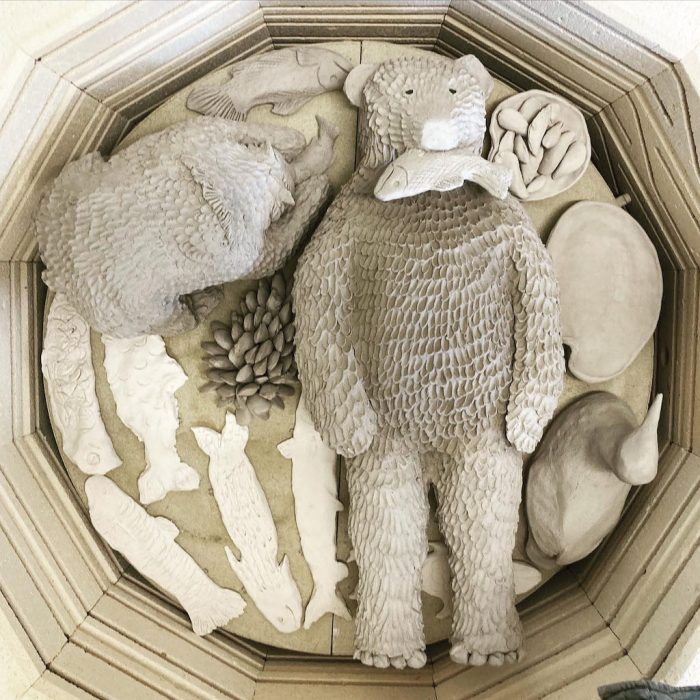
You’re one of the founders of the Lucky Bat system. How did Lucky Bats come to be?
What is the purpose of a bat in pottery, and what makes Lucky Bats different from others on the market?
In 2021, I had just graduated from Emily Carr and was starting up my ceramics practice. My Dad is a carpenter, and he had recently invested in a CNC, a computerised router.
I wanted a bat system for my pottery practice, but everything on the market was outside of my budget. A bat is a surface that is placed onto the wheel that a potter can throw on, and then when the potter is finished, they can lift the bat off of the wheel, replace it with a fresh bat, and get back to throwing. In this way you can work rapidly and not have to worry about lifting wet work off of the wheel, potentially damaging it. It helps you work consistently and reduces the time it takes to trim your work later on.
So I showed my dad what was required to make a good bat and insert, and we set about designing and cutting out the Lucky Bat System. We have explored which materials are best suited in terms of wear and tear through use, as well as in terms of sustainability.
We settled on 1/4” formaldehyde-free MDF for the insert, and 3/4” birch plywood for the bat. It was important to me to use materials that are not plastic and do not contain harsh binders and preservatives. These materials will last a long time if they are properly cared for, but they will also decompose when they are disposed of. Cutting plastic with the CNC would create microplastics, which I don’t want to do. Also, plastic inserts can degrade through use and become wobbly, same with the area around the bat pin hole on the bat.
Lucky bats swell slightly with the water they are exposed to when you throw, and this prevents that degradation as well as keeps everything nice and snug. Lucky Bats are also unique because of the shape of the insert, a heptagon. The seven-sided shape keeps the insert from wobbling, and it is also cute. Cleanup of the insert is a breeze because the edge is rounded, making less area for the clay to get stuck to. The reverse side of the bat is flat and engraved with concentric circles, which are useful visual guides for centering your work when you are ready to trim.
Aside from Lucky Bats, what are your favourite pottery tools?
I love Xiem’s scratch tool for carving clay, and their bevel cutter for cutting slabs. I use Mudtools’ flexible ribs for throwing, as well as generic yellow coin sponges and a shammy for rims. My favourite clay knife is the Dolan DPT220, and I love Dolan trimming tools as well. I also trim with a Mudtools small shredder blade.
For decorating and hand-building, I love the Shimpo BW-25LC banding wheel, that will be my next pottery equipment purchase.
We’ve recently brought in Moroccan Sand Glazes from Laguna, and asked you to try them out for us. How did you enjoy them?
I tested them on all the clay bodies I use, and found them to give consistent, flawless results.
I have always made my glazes from raw materials, this is my first time using commercial glazes, and what struck me was that every glaze worked well on every clay body, which is not always the case when you are making your own glazes.
I also had never used a brush to apply my glaze, normally I dunk or spray. Using a brush-on glaze eliminated the need to use wax resist on one of my designs, the Seaweed mugs. With a Seaweed mug, I draw my design in pencil onto the bisqueware, paint wax onto the area I want to remain unglazed, and then dunk the cup into a bucket of glaze and wipe clean the waxed area. This makes a pattern and texture of glazed and unglazed surface on the cup.
But with Laguna Moroccan Sand Glazes, I was able to just paint the glaze into the area of toy drawing that I want glazed, and not bother with the finicky wax resist process.

I’m looking forward to working more with them, and to exploring painterly glaze applications, taking advantage of their precision and layerability.
Where can people find your work or see more of it online?
My work can be seen online at clarewilkening.com, and on Instagram @clarewilkening.ceramics.
I will have the Orca Tiles up for a Water Show at Tidal Art Gallery in Lund from July 1 – August 7th, and I will be participating in the Sunshine Coast Pottery Prowl July 9th/10th.
The Pottery Prowl is new this year, potter’s up and down the Sunshine Coast will be having open studios that weekend.
Upcoming Opus Creative Demo
Lucky Bats – Wheel Techniques with Clare Wilkening
Thursday, June 09, 2022 at 11am PST
Join Clare Wilkening in this fun demo and learn how to throw multiple cups during one session using the Lucky Bat. The demo will start off with choosing how much clay to use and how to centre the clay.
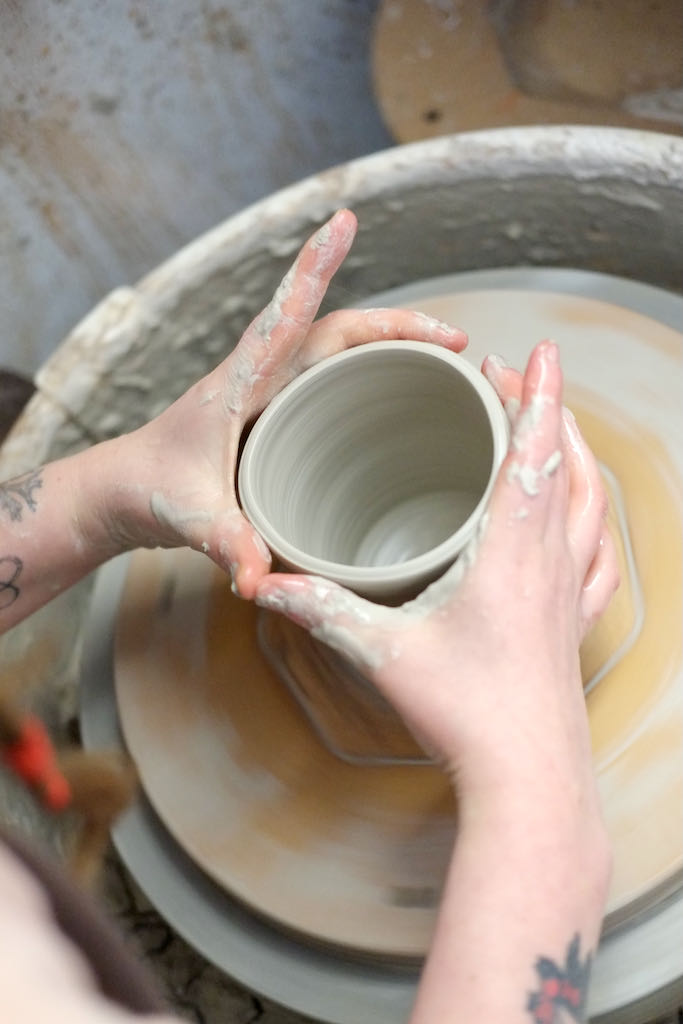
About Clare Wilkening
Clare Wilkening is an emerging ceramic artist from Vancouver, BC. Clare’s work utilises ceramic forms to evoke, narrate, and respond to specific places and ecological issues.
Clare holds a BSc. in Environmental and Agricultural Science from McGill University, a BFA in Visual Arts (ceramics) from Emily Carr, and has recently been the ceramics Artist-in-Residence at Tidal Art Centre in Lund, BC.
Clare has a unique way of looking at the world and seeing solutions that span disciplines and contest binaries. This is part of the reason that ceramics has been perfect for her, because ceramics inherently contain oppositions such as mass/volume, inside/outside, surface/form. Clare’s work has a strong foundation in drawing, which she uses to generate forms and my surface imagery. Clare is completely gripped by clay and looks forward to a lifelong engagement with this material.
